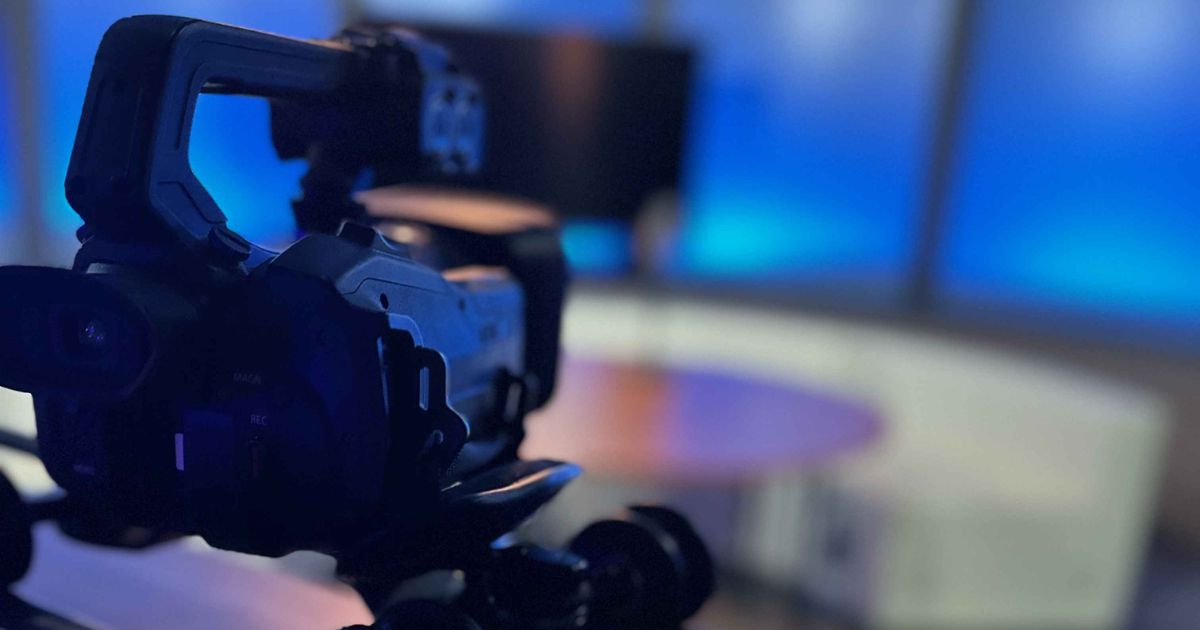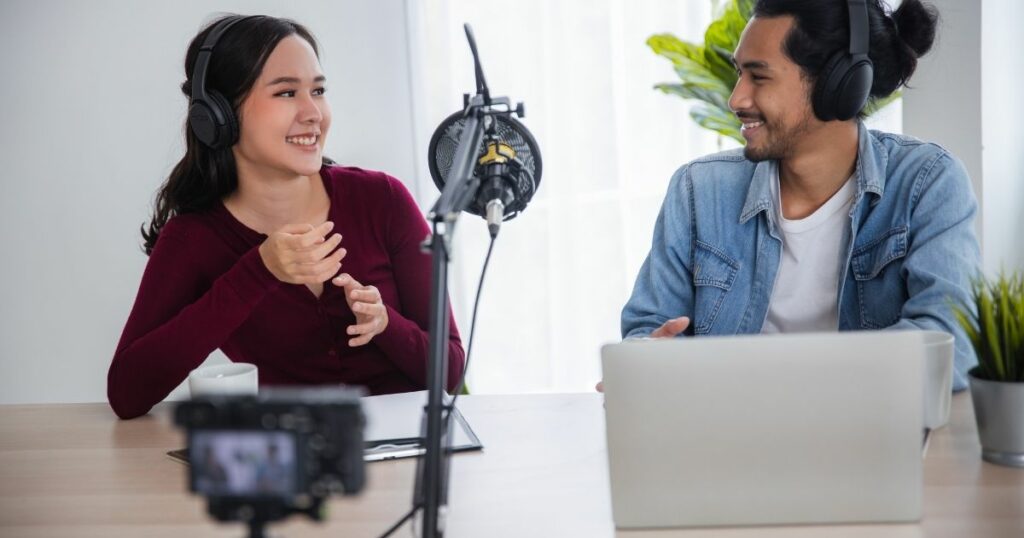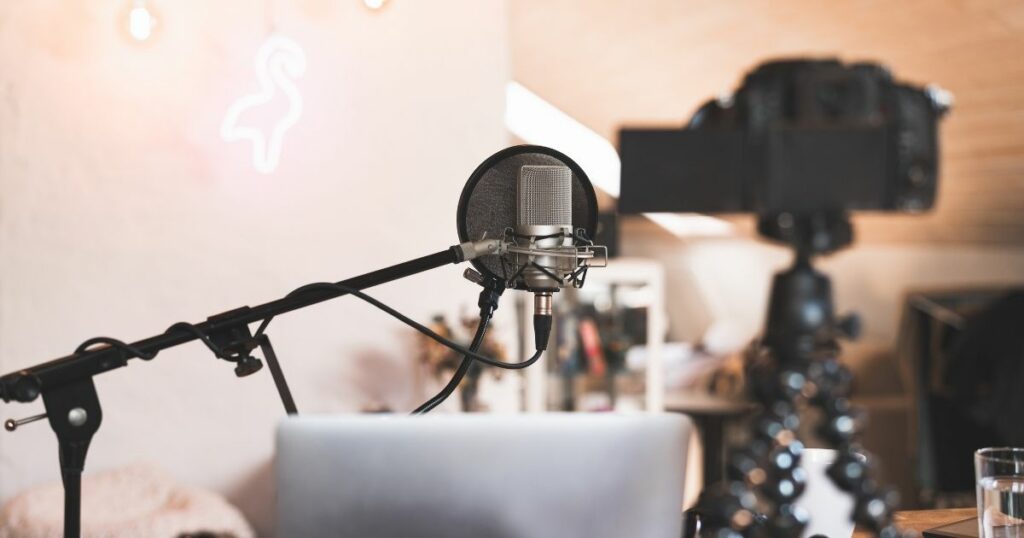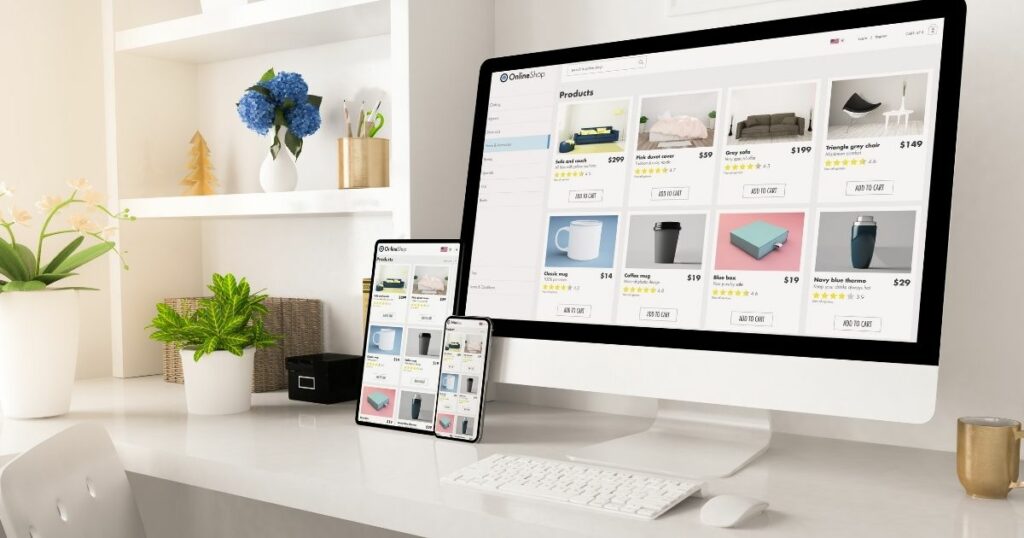Video Marketing Transcript
Season 2 Episode 9
This is a written Transcription for the episode: Reels, TikToks, and YouTube Video Shorts Of the Midwest Mindset podcast.

Full Written Transcript of The Episode
Matt Tompkins: Are you ready to take your social media game to the next level? Well, it’s time to embrace this truth. Facebook and Instagram are now video platforms just like TikTok and YouTube. This means that video based marketing is the way of the future.
In fact, it’s happening now. So if you’re not creating videos for your business on a consistent basis, you’re simply not in the game. But don’t worry. In this episode today, we are here to help you navigate the world of video marketing. We’re going to answer questions like, Should you be posting vertical videos or widescreen format, short or long form? And what’s the real impact on your business?
In this episode, we’re joined by Walt Sanders and Michael Murphy of Omaha’s own Wmk Media, and they’re going to show us exactly how to use video to grow your business. Hello and welcome back to Midwest Mindset, the podcast that gives you the small business owner, the big agency Secrets to Marketing. I’m Matt Tompkins of two Brothers Creative, where we believe every business deserves affordable and effective marketing.
Now Walt and Murphy of Wmbc Media have not only turned their own YouTube channel into a monetized profit machine as part of their business, they help small businesses do the same thing with their video content every day. But first, I think it’s important to understand why video content is the most effective tool to market your business today and to also understand why these vertical videos are so popular.
Matt Tompkins: Where do they come from? Well, to answer that question, we’re going to have to travel way back in time, back in the day to the dawn of Snapchat.
Yes, Snapchat was actually the first social platform to incorporate vertical videos, and they did it for obvious reasons. First, 80% of all social media users are on their phones, 80% Snapchat. They tapped into something pretty big with these vertical formatted videos because what they found was that of all those people on social media, only 15% of users would turn their phone for a widescreen video.
And this meant that you were leaving a lot of real estate unused. In fact, vertical videos versus widescreen. When the phone is held horizontally like you’re talking on it, they take up 78% more space, They fill up the entire screen and that means you now have just gained 100% of the user’s attention.
After Snapchat came another big sea change in how social media channels worked. And that was tick tock. Tick Tock took the same addictive, newly discovered vertical format videos and they applied their new algorithm that was different from Facebook, Instagram and YouTube in one major way Facebook, Instagram and YouTube. They were network based algorithms, which simply means that they would place your content in front of people who knew you liked your page or followed you. Tick tock. They started placing videos in front of complete strangers, first using their very advanced algorithm to find the best suited viewers for your specific content.
Matt Tompkins: The massive success of TikTok. It forced the other social media giants to change, and Meta quickly created reels for Facebook and Instagram.
Google launched YouTube shorts for YouTube. I share all of this with you, not for the history lesson, but it’s because this is important. It’s important to know this because this defines why video content is the single biggest opportunity for marketing your business.
All of these platforms are now placing your vertical video content in front of new people, in front of complete strangers. And we’re talking tens of thousands of people, which is the entire goal of being on social media in the first place, right? For your business to be discovered. We’ve seen brand new YouTube channels with just five subscribers, get tens of thousands of views with their vertical video shorts. And today, Walt and Murphy of Media are going to give us the ultimate playbook for video content marketing.
So first we talked about which format you should use, vertical or widescreen. In my opinion, mixed formats of both. You need to have your long form content that’s going out. I don’t know. Weekly Maybe you’re making a post that’s once a week or once every month even where you’re spending more time on that one specific style of video. That’s your long form video, that’s your widescreen. Then you take your verticals and cut it out of the the macro content, if you will. Yeah.
Walt: Yeah. And really, it’s more about more verticals, less horizontals. Yeah. So if you will, the ratio you want the mainstay video and you want shorts that lead people back to that mainstay. The thing about shorts is what you’re doing with those vertical shorts is, you know, brand awareness. The age old rule, if it takes 7 to 8 impressions for somebody to actually click through and investigate further who you are as a company.
So you want as many impressions as you can get with your brand with those vertical shorts so that when they want to find out more, they’re getting to that meaty content that’s that horizontal and that’s when they that’s when they start to learn about your company as a culture, your company. What is it They actually offer some customer testimonials and stuff like that.
Matt Tompkins: The answer is both. Yes, we should be posting both vertical and widescreen videos because they have different purposes, not just between the two different formats of video, but between all the different social platforms and how they work.
The other question we get asked a lot that I brought up with Walt Murphy is how often should I be posting videos? Yeah, go.
Walt: Ahead. Go first. I just want to say if you’re only going to do it very seldom, like once a week, you know, three times a month, there’s not even a point in posting videos. Really? Okay. So the main thing is at least five videos a week. Nice. Okay. Them on the like. That’s minimum. Yeah. Make your first goal to post once a day Monday through Friday.
Matt Tompkins: In the vertical format.
Walt: And try to get a horizontal in there.
Matt Tompkins: Yeah like maybe maybe like 1 to 2 three minute horizontal video. It’s a little more meatier, more in depth content, and then a single vertical video, at least every single day of the week.
Murphy: If you can find us that to be sustainable, if you can find it to be sustainable to to post five, six times a day vertical format, do it because we don’t we’re not running into the same issues that we did back in the day. If you used to spam the Facebook wall, everybody would hate you, you would be annoying and then you keep popping up.
We don’t have that issue with reels because it’s getting put out in front of a new audience and the algorithms selecting where where it goes. Essentially, you don’t have to worry about spamming as much You can you can drop a ton of content throughout the day and a lot of times the same people, unless they’re following you, aren’t even going to see the same video twice.
Matt Tompkins: This is a common thing with all business owners where we think that we’re posting or sharing too much about ourselves. We think we’re making the call to action too much. But trust me when I tell you we’re not even coming anywhere close. In fact, most of us business owners, we don’t make the ask enough. You have to keep in mind the marketing rule of relativity, which, yes, I just made up. But this simply means that your audience does not see your content as frequently as you see your content. You are in the weeds.
You’re going to get sick of yourself, your videos, your content, but that’s because you are seeing it too much. Your audience does not see it anywhere close to enough, let alone too much. So don’t base your decisions on how often you see it. Base your decisions on how often they see it. Are you going to make reactionary choices that negatively impact your results? Well, we.
Walt: Remind clients all the time to is, you know, we’re not making a sales pitch over and over again. We’re positioning ourselves as thought leaders in the industry. The sales pitch is that you’re talking about things that are related to your industry, so therefore you’re being looked at as an expert in some people’s eyes. And with that brand awareness, then comes the sales pitch after they reach out to you, right? So we’re talking all top of the marketing funnel stuff. It’s just push, push, push.
And like he said, I ran an experiment the other day on our YouTube channel and I posted the same short. The original one was 47 seconds long. The other ones were 22 seconds, 11 seconds, just varying lengths. But same content posted them all at the same time, all at 11 a.m., eight of them on YouTube. Channel three of them got over thousands of views.
A couple of them got like 30 views and then some were right there in the middle with like 500 views. Yeah, but it just and they were all unique viewers. Okay. So that goes to show that the algorithm just said, hey, all this content, give it to all these other unique viewers rather than just a whole bunch of nobody except for my subscribers or our subscribers, saw all the videos pop up in their feed. And I did have a couple people be like, Why did you post the same thing? We’re experimenting.
Murphy: Yeah.
Walt: And you do have to do that. Yeah, yeah. And a lot of times we have to caution clients into thinking that there’s going to be immediate success and immediate results when they see these short format and start posting so consistently.
You got to think of the first six months is data collection. Yep. Right. All the ideas that you have for your content. Let’s do those ideas. Let’s get them out on a consistent basis in a vertical and horizontal format. Come back in six months, look at the data and say, All right, out of these six ideas, these are the three we’re going to stick to. Yeah.
And I also, you know, we need people to be thinking in the in the way of like, okay, we’re going to have a YouTube channel, we’re going to make one style of content. You got to think of it as a variety show. There’s it’s the opportunity to have different skits, if you will, different episodes or different styles of content, and you want to have three that are somewhat closely related. So you’re not going to alienate anybody from your audience, but you want to have those three that you can just always be leaning on. And then people can see different range from you rather than just a one trick.
Murphy: And in order to find those three, you had to try ten different styles of videos and see what works and what didn’t work and collect data.
And you can’t just post one kind of video one time at one time of the day with one form of edit and be like, Oh, I guess that video didn’t work. If it didn’t work the first time, recut it, re-edit it, restructure it, tag it differently, try it, try different, try to post it at a different time of day. And as you do that, then it’s like, okay, no, this video is trash. This video worked, you know? Yeah.
Matt Tompkins: The next important factor to video content marketing is how you look on video matters more for business owners and businesses than individuals.
Quality matters because what we’re doing here is we’re establishing the very first impression that prospects new customers are going to have about you and thus your business that’s going to be formed in literally a split second at the longest a few seconds into your video. So quality matters with your videos for a business.
Walt: Feel like I need to go home and change my face.
Murphy: That’s funny.
Matt Tompkins: No, no, no, no. Um.
Murphy: You.
Walt: You’re totally right. Yeah, you’re totally right, though. The beautiful thing about analytics today, there’s a new. Analytic in YouTube on the shorts that says swipe swipe away or stayed on. Yeah. Okay. So you can now see the percentage of the people that actually got eyes on that vertical. Okay. Did they swipe up or not? And you always are going to want to be on the positive side of 50% stayed on.
Matt Tompkins: It’s like my dating app back in the day. It’s like there’s too many swipe lefts. Yeah.
Walt: They’re like, you only considered it for two seconds, man. Wrong with you. Come on.
Matt Tompkins: Damn. I mean the numbers game, right?
Walt: Like. Like. Like. Like. Like.
Murphy: Like someone’s got to.
Walt: Figure it out in the.
Matt Tompkins: Chat. The next thing we’re going to talk about is tags. What are tags? Well, tags are simply keywords or words related to your particular video content. So if you’re posting a video on YouTube about how to make homemade meatballs, some of the tags you would include in the tag section of your YouTube video would be Meatballs and Homemade Meatballs and How to Make Homemade Meatballs. And you’re allowed hundreds of tags.
And this is an opportunity you want to take advantage of. They’re not the be all end all, but they are important. So don’t just post a video without any tags because it’s these tags or these keywords that are telling YouTube what your content is about so that YouTube can place your video in front of the right people. Murphy walked us through some important and highly effective techniques for managing those tags in your videos. To me.
Walt: Tags are super important. Youtube does, actually. They do use their algorithm to filter out unrelated content. So if you’re tagging for something like if you put Donald Trump because you know it’s a trending tag, if you put that in your tags and your video doesn’t mention the words Donald Trump, they’re going to just not filter you into the Donald Trump stuff. So you’re wasting your energy at that point. So YouTube is smart enough for that. Put as many tags as you can possibly find that are related to related. Yeah. And just use chatgpt to generate them. Yeah.
Matt Tompkins: And I will say this, let’s back up for just a second cause we need to mention what tags are. Okay. Yeah. Tell people that tags are like what are they.
Walt: Well tags are keywords that you put into the tag area of the YouTube video, but the whole description and the title, those are all used as tags as well. So it’s very important on YouTube if you’re listening. This is been out there forever, but it freaking works. It’s how we got our channels started. I mean, we had 2 million views in the last year.
The title of the video that you upload to YouTube should have all the most popular tags for that video in it because that is actually embedded in the title of the file into the the title of the file that you upload. So you definitely want it to be the same as what you want it to be searched for. Like, you know, the Midwest. Yeah.
Matt Tompkins: Mindset.
Walt: The Midwest Mindset podcast would be the title. Then you would say you know hyphen entrepreneur hyphen, new business hyphen, startup hyphen, advice hyphen. And then you can only have so many words in the title, but you just get the most important tags in there.
And then as you upload it to YouTube, that automatically those tags, if you go and look at the source code behind your pages, you’re going to see that the title is still the same, even though even though you changed the front facing title, it’ll actually the code will right Here’s the front facing title and here’s the actual original file upload. Okay, that’s a good tip. And then you go to chatgpt and type in, write a video about Matt talking to Walt and Murphy from Media.com about what it means to be an entrepreneur in the Midwest. Yeah, and just take that description that it writes for you. It’ll be 3 to 4 well-written paragraphs that actually purposely includes buzzwords, and it’s going to be creepy because you’re like, Wow, they actually know what my company does.
Matt Tompkins: We’ve been talking about things you can do to your video once you’ve uploaded it to YouTube, like changing the video’s title, ensuring in the description, putting in those tags, those keywords. But there’s something you need to do before you even upload it to YouTube and that is how you title your video.
Don’t just title your video when you save it to your desktop computer. Do not just title it something like video number one and then upload that to YouTube because YouTube pulls that information. It’s what we call metadata. It pulls that information from the original video file and that factors into it. Putting your video in front of people. Even if you change the video’s title in YouTube once it’s uploaded, YouTube is still pulling information from the original video file, so title your video appropriately. You can even include, as Murphy talks about here, those keywords that you want to target in the title of your raw video file.
Walt: So the process we go through is all those tags are in the title of the file, upload it title it appropriately. If it’s a short, always put hashtag shorts in the title in that description box. Always put three hashtags because those are the you can put six, but they’ll only list three on the actual viewing page. And then under that, that description that you get generated by Chatgpt because it’s going to have the most amount of buzzwords, those are all going to be tags go down, put all the tags in the tag box that you can possibly think of.
Always make sure you choose the language of the video as English and always put the location the location was filmed or where you’re targeting. Yeah, we’re filming. Is in Omaha. But if you’re running a campaign in Tennessee, Tag It was filmed in Tennessee and that will naturally feed it to people that are in Tennessee. And then if you’re tagging correctly, we just did this for a client. I just tagged a video that it was made in Tennessee because he wants to talk to athletic directors in Tennessee. It’s an athletic director testimonial. So we can now go and look at the analytics and see that people that are interested in athletic director stuff in Tennessee saw those videos. Nice. So when they go to a conference there in two months. Yeah, there should be some brand awareness.
Matt Tompkins: What you title the original raw video file, the description, the tags that you include, the location it was filmed, the language, the video is in the date it was recorded. All of these things add up. Even the thumbnail graphic that you choose actually factors into YouTube’s algorithm.
Murphy: If you have a video that you know is fire and it’s not getting traction, just try to redo the thumbnail. Yeah, try to redo it and see what happens. And I guarantee that click through rate starts to go up. Yeah, that’s.
Walt: One thing that impresses me. I can go look at a video we posted a year ago and it’s got like the lowest impression click through rate possible. And then you go and look at the impressions that it’s still getting after a year. It’s just a straight up line. So you’re missing all this opportunity for that whole year that that thumbnail sucked. Oh yeah, right. So a thumbnail. The best thumbnails, especially when it does involve people in the video, is to have up close to the face some sort of emotion on the face.
Matt Tompkins: And that make that face of that human big in the thumbnail so it can be seen and recognized.
Murphy: Absolutely.
Walt: And in background, minimal words too. Yeah. I always thought it would help. But you look at evidence. Yeah. If you use.
Murphy: If you do use words, make it count. Like make it an impactful statement that makes them It’s a hook. It’s supposed to make them have to click on the video like arrested. Yeah. Yeah.
Walt: Like something like that and then have it. Yeah. Yeah. They don’t.
Murphy: $1 million in damage don’t.
Walt: Duplicate the words that are in your title either because now you’re just wasting space because like they’re already seeing the title.
Matt Tompkins: Seeing the title. Another very common question is how long should my videos be? And the answer is difficult because this does vary as Murphy talks about here in just a second, depending on the content.
But I will tell you this much with the vertical videos, in particular, the Facebook, Instagram reels, TikTok YouTube shorts, you want to accomplish the goal of your video, that impression, whatever it is that you want to leave with people in the first five seconds, the first five seconds needs to hook them. Then you deliver the story, the substance, the content, and then you need a call to action. A CTA. It’s Hook story Call to action. That’s the format that we’ve seen work really, really well with these vertical video shorts.
Walt: Yeah, it’s all based on format too though, correct? Um, yeah. If it’s a podcast, it could be three hours if you really want. Yeah, right. But are you popular enough to retain an audience?
Murphy: Like a reaction video is going to be like three minutes, you know what I mean?
Walt: But but if you’re, if you’re just starting out like and you’re trying to position your if you’re a company and you’re trying to position yourself as a thought leader, let’s start off with a five minute talking head video where we’re just talking directly into the camera, right? And I’m sharing information about the oil industry because I’m big in that field. And then you take, you know, out of that five minutes, we all know you’re going to get 10 to 15 shorts out of that. Now you’ve got three weeks of content just from that one sitting down talking head for five minutes. Yeah.
Matt Tompkins: If there’s only one thing that you take away from this episode here today in regards to video content, I hope it’s this You need to have a strategy. You need to have a plan. You know, planning gives your strategy, it gives your video content focus.
You have an intent, you know what the intention is, and you have a way to measure results because now you know what you want to get out of it, but it also gives you and your team time to execute and maintain this new commitment to content marketing. Don’t just start posting today. I mean, if you’re excited, you’re hearing all these great techniques and tips from Walt Murphy. I’m thrilled to hear you’re excited, but don’t just start posting today. You need to have a plan in place first.
Walt: Don’t start posting until you have 30 days in the can and ready to post and have that scheduled out to give your team that’s doing it some breathing room to give yourself leeway for vacation time. Yeah, things like that. Or the.
Matt Tompkins: Shit happens. Claus Man.
Walt: You could be very strategic about it. Now, one thing to keep in mind, like that power washing company. I know you’re watching, um, one day you’ll get paid for that brand awareness because videos like that will get you to a certain point of subscriber base, will get you monetizable on YouTube. And now it’s like, okay, we’re making these videos, we’re getting brand awareness and we’re making a couple hundred dollars on it.
Matt Tompkins: Now, I’m not going to lie content marketing. It is a commitment. It’s a lot of work and that’s why planning ahead helps tremendously. But this will have a snowball effect over time. You’re going to be able to repurpose a lot of these different videos on different social media platforms, and I think that’s.
Murphy: How you get to posting 5 to 7 times a day is like compound over time if you’re posting one video a day, right? Well, in three months you’ll be able to repost that same video again and you end up just layering up and you’re reusing the same content over and over again in a cycle over, you know, three four month increments.
Matt Tompkins: Content marketing is all about the long game right now. You may feel like you’re just in this day to day treading water, just keeping the head above water mindset. And I get that. I know. I know how that feels. I’ve been there too.
Most business owners, we are in that same place. Content marketing is not a brute force sales approach. It’s not an approach that’s going to generate leads tomorrow. But what it’s going to do is it’s going to take that S-curve, that up and down, that up and down that we see as business owners, and it’s going to level it out to where it’s a nice, steady incline.
Things like video content, search engine optimization, having a website, having the right social media channels, having a strategy behind it all that ties it all together. That is how you get to one year from now, six months from now, two years from now, where you don’t even have to stress because you already have this laid out. You have built this foundation to an indestructible approach to making more money. A huge thanks to Walt and Murphy of Wmk Media for coming on the podcast here today. I’ve got a link to Wmk Media’s website in the show notes, also in the show notes.
This is a very cool resource for you. It’s not even from me or Walter Murphy, it’s from YouTube. Yes, YouTube issued this 67 page guide to all the latest and updated best practices for monetizing and getting more reach, more views, and more impact from your video content on YouTube. It’s a PDF. You can click on the link and download it absolutely free in the show notes and we will close out the show with a call to action from Walt and Murphy themselves for WMr Media here on Midwest Mindset.
Walt: Are you tired of putting out content that sucks?
Murphy: I’m tired of you putting out content that sucks.
Walt: No, legitimately though, we need to have a deep talk. Come a little closer.
Murphy: This is getting intimate. I need. I need you guys to understand something.
Walt: If you’ve been afraid to pull the trigger on making good content and growing your influence and brand awareness, WMr media.com are the guys for you.












































